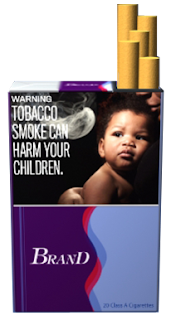 Today is the beginning of the end of the tobacco epidemic. You may have already heard about the new dramatic graphic labels that are being proposed for every pack of cigarettes, which are the biggest step forward in 25 years to warn people about the dangers of smoking and help people stop before they start -- but that’s only part of it.
Today is the beginning of the end of the tobacco epidemic. You may have already heard about the new dramatic graphic labels that are being proposed for every pack of cigarettes, which are the biggest step forward in 25 years to warn people about the dangers of smoking and help people stop before they start -- but that’s only part of it.Today, this administration, through the work being done at HHS, is unveiling its first ever comprehensive tobacco control plan – laying out strategic actions that will serve as a roadmap to reduce smoking rates, help tobacco users quit, and prevent children from starting to smoke in the first place.
Every day, nearly 4,000 kids under 18 try their first cigarette, and some 1,000 kids under 18 become daily smokers. And 443,000 Americans die prematurely each year from smoking and second hand smoke exposure, making it our country's leading cause of preventable death. It also costs our health care system almost $100 billion a year.
When this Administration took office, we decided that if these numbers weren’t changing, our actions had to – which is why today marks an important milestone in protecting our children and the health of the American public.
The strategic action plan unveiled today includes a proposed rule issued by the Food and Drug Administration (FDA) titled Required Warnings for Cigarette Packages and Advertisements. Specifically, the proposed rule will drastically change the look and message of each pack of cigarettes by adding new graphic warning labels with pictures showing the negative health consequences of smoking, including some images of the damage that cigarettes do to our bodies to every pack.
When this rule becomes effective in 2012, people who pick up packs of cigarettes are going to know exactly what risks they are taking. Ultimately, companies will be prohibited from manufacturing cigarettes without new graphic health warnings on their packages.
This rule is in addition to progress we’ve already made to encourage people to quit smoking, and to prevent them from ever starting, after historic legislation passed last June gave FDA the prohibiting marketing aimed at children.
And, for the first time, Medicare will cover tobacco cessation for all beneficiaries, allowing people to get help quitting tobacco before they get sick.
We are also funding comprehensive state and local programs around the country for reducing tobacco use – programs like the one in Ringgold County, Iowa, where they are using evidence-based tobacco control interventions to decrease tobacco use in low-income, rural populations.
These are just some of the strategic actions in our comprehensive tobacco control plan.
Going forward, HHS has charted a clear path to ending tobacco use in our country. We have a long way to go, but we won’t rest until we’ve eliminated tobacco-related disease and suffering. The prosperity and health of our country depends on it.

0 comments:
Post a Comment